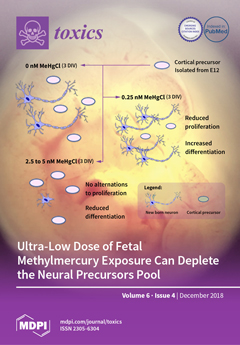The aim of this study was to evaluate the in vitro effect of different doses (50, 100, 200, 400, and 800 mg/L) of Fe
3O
4 nanoparticles (NPs) at 4 °C for 24 h on the kinematics of rainbow trout (
Oncorhynchus
[...] Read more.
The aim of this study was to evaluate the in vitro effect of different doses (50, 100, 200, 400, and 800 mg/L) of Fe
3O
4 nanoparticles (NPs) at 4 °C for 24 h on the kinematics of rainbow trout (
Oncorhynchus mykiss, Walbaum, 1792) spermatozoon. Firstly, Fe
3O
4 NPs were prepared at about 30 nm from Iron (III) chloride, Iron (II) chloride, and NH
3 via a co-precipitation synthesis technique. Then, the prepared Fe
3O
4 NPs were characterized by different instrumental techniques for their chemical structure, purity, morphology, surface properties, and thermal behavior. The size, microstructure, and morphology of the prepared Fe
3O
4 NPs were studied by Fourier transform infrared spectroscopy (FTIR), X-ray diffraction (XRD) spectroscopy, and scanning electron microscopy (SEM) equipped with an energy-dispersive X-ray spectrometer (EDS). The thermal properties of the Fe
3O
4 NPs were determined with thermogravimetric analysis (TGA), differential thermal analysis (DTA), and differential scanning calorimeter (DSC) analysis techniques. According to our results, there were statistically significant (
p < 0.05) decreases in the velocities of spermatozoon after treatment with 400 mg/L Fe
3O
4 NPs. The superoxide dismutase (SOD) and catalase (CAT) activities were significant (
p < 0.05) decrease after 100 mg/L in after exposure to Fe
3O
4 NPs in 24 h. As the doses of Fe
3O
4 NPs increases, the level of malondialdehyde (MDA) and total glutathione (tGSH) significantly (
p < 0.05) increased at doses of 400 and 800 mg/L.
Full article






